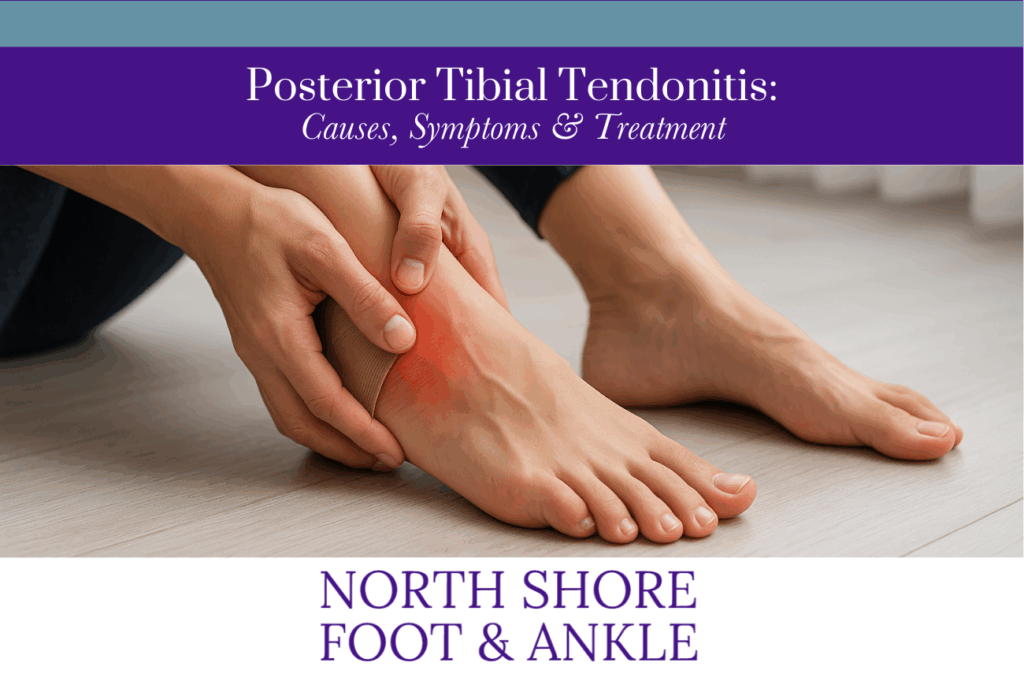
Posterior Tibial Tendonitis is a common yet often overlooked condition that affects the tendon supporting the arch of the foot. This tendon runs along the inside of the ankle and foot, playing a crucial role in stability and mobility. When injured or inflamed, it can cause significant pain, loss of arch support, and even long-term disability if left untreated. At North Shore Foot & Ankle, our experienced podiatrists provide advanced diagnosis and treatment to help patients find relief and restore healthy movement.
What Is Posterior Tibial Tendonitis?
Posterior Tibial Tendonitis occurs when the posterior tibial tendon becomes inflamed or damaged due to overuse, injury, or degenerative changes. This tendon is responsible for supporting the arch of your foot, so when it weakens, the arch may collapse, leading to flatfoot deformity and chronic pain.
Common Causes
- Overuse or repetitive stress (running, high-impact activities, or prolonged standing)
- Acute injury (a sudden fall or twist of the ankle)
- Degenerative changes (tendon wear-and-tear with age)
- Obesity or poor biomechanics (which increase strain on the tendon)
Symptoms of Posterior Tibial Tendonitis
- Pain along the inside of the foot and ankle
- Swelling around the tendon
- Difficulty standing on tiptoe
- Flattening of the foot arch (progressive flatfoot)
- Pain that worsens with activity
Treatment Options
At North Shore Foot & Ankle, treatment is tailored to the severity of the condition:
- Conservative Care
- Rest, ice, and anti-inflammatory medications
- Supportive shoes and custom orthotics
- Physical therapy to strengthen surrounding muscles
- Bracing for additional support
- Rest, ice, and anti-inflammatory medications
- Advanced Treatments
- Corticosteroid injections (in select cases)
- Extracorporeal shockwave therapy (to stimulate healing)
- Corticosteroid injections (in select cases)
- Surgical Options
For advanced tendon tears or severe flatfoot deformity, surgery may be necessary to repair or reconstruct the tendon and restore function.
Q&A: Posterior Tibial Tendonitis
Q: Who is most at risk for posterior tibial tendonitis?
A: Athletes, individuals with flat feet, people who are overweight, and adults over age 40 are at higher risk due to tendon strain and natural wear over time.
Q: Can posterior tibial tendonitis go away on its own?
A: Mild cases may improve with rest and conservative treatment, but without proper care, symptoms often worsen and can lead to permanent flatfoot deformity.
Q: How do podiatrists diagnose this condition?
A: Diagnosis includes a physical exam, gait analysis, and sometimes imaging studies like ultrasound or MRI to evaluate tendon damage.
Q: What happens if it is left untreated?
A: Untreated tendonitis can progress to posterior tibial tendon dysfunction (PTTD), causing arch collapse, chronic pain, and mobility limitations.
Q: Are orthotics effective for tendonitis?
A: Yes, custom orthotics can reduce strain on the posterior tibial tendon and improve arch support, providing both relief and prevention of further damage.
Contact North Shore Foot & Ankle
If you’re experiencing persistent ankle or foot pain, don’t wait until it worsens. Our expert team at North Shore Foot & Ankle is here to help.
📍 Lynbrook Podiatry Office
50 Hempstead Ave, Ste B, Lynbrook, NY 11563
📞 (516) 599-0302
📍 Syosset Podiatry Office
175 Jericho Turnpike, Suite 300, Syosset, NY 11791
📞 (516) 496-7676
📍 Flushing Podiatry Office
72-03 164 St., Flushing, NY 11365
📞 (718) 591-3320
📍 Rosedale Podiatry Office
140-04 248 St, Rosedale, NY 11422
📞 (718) 949-4844
📍 Plainview Podiatry Office
1144 Old Country Rd, Plainview, NY 11803
📞 (516) 942-0620
🌐 Visit us online: northshorefootandankle.com








